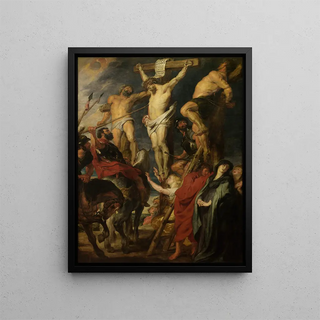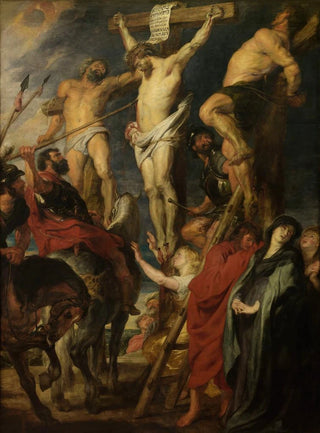Art print | Christ on the Cross Le coup de lance - Antoine van Dyck


View from behind

Frame (optional)
In the fascinating world of Baroque art, "Christ on the Cross Le coup de lance" by Antoine van Dyck stands out as an iconic work, revealing the spiritual and emotional depth characteristic of this period. This piece, illustrating the crucifixion with poignant intensity, invites viewers to a contemplative reflection. The depiction of Christ, suspended between heaven and earth, captures attention with his expression that is both painful and serene. The play of light and shadow, typical of Baroque style, enhances the drama of the scene, creating an atmosphere that is both solemn and captivating. This painting, through its strong iconography and masterful execution, transcends the mere pictorial frame to become a true meditation on suffering and sacrifice.
Style and uniqueness of the work
The uniqueness of "Christ on the Cross Le coup de lance" lies in its ability to fuse impeccable technique with palpable emotion. Van Dyck, master of portraiture and composition, manages to capture the very essence of human suffering through the body of Christ. Every detail, from the folds of the drapery to the expressions of surrounding figures, demonstrates unparalleled technical mastery. The choice of colors, ranging from dark tones to luminous highlights, creates a striking contrast that draws the eye and guides contemplation. This artwork is not limited to a religious representation; it also evokes universal themes such as pain, redemption, and hope. The presence of the lance, a symbol of inflicted suffering, adds an extra dimension to the piece, making the scene even more poignant and evocative.
The artist and his influence
Antoine van Dyck, a pupil of Rubens, established himself as one of the great masters of Flemish Baroque. His career, marked by travels to Italy and England, allowed him to incorporate diverse influences while developing a distinctive style characterized by elegance and unparalleled fluidity. Van Dyck redefined portraiture, transforming it into an art form capable of conveying not only appearance but also personality and

Matte finish

View from behind

Frame (optional)
In the fascinating world of Baroque art, "Christ on the Cross Le coup de lance" by Antoine van Dyck stands out as an iconic work, revealing the spiritual and emotional depth characteristic of this period. This piece, illustrating the crucifixion with poignant intensity, invites viewers to a contemplative reflection. The depiction of Christ, suspended between heaven and earth, captures attention with his expression that is both painful and serene. The play of light and shadow, typical of Baroque style, enhances the drama of the scene, creating an atmosphere that is both solemn and captivating. This painting, through its strong iconography and masterful execution, transcends the mere pictorial frame to become a true meditation on suffering and sacrifice.
Style and uniqueness of the work
The uniqueness of "Christ on the Cross Le coup de lance" lies in its ability to fuse impeccable technique with palpable emotion. Van Dyck, master of portraiture and composition, manages to capture the very essence of human suffering through the body of Christ. Every detail, from the folds of the drapery to the expressions of surrounding figures, demonstrates unparalleled technical mastery. The choice of colors, ranging from dark tones to luminous highlights, creates a striking contrast that draws the eye and guides contemplation. This artwork is not limited to a religious representation; it also evokes universal themes such as pain, redemption, and hope. The presence of the lance, a symbol of inflicted suffering, adds an extra dimension to the piece, making the scene even more poignant and evocative.
The artist and his influence
Antoine van Dyck, a pupil of Rubens, established himself as one of the great masters of Flemish Baroque. His career, marked by travels to Italy and England, allowed him to incorporate diverse influences while developing a distinctive style characterized by elegance and unparalleled fluidity. Van Dyck redefined portraiture, transforming it into an art form capable of conveying not only appearance but also personality and






